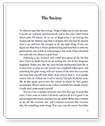Your essay description is the most important part of the order process, but it does not have to be complex. Simply provide us with as much detail about the essay as possible. In some cases, the description could be one or two sentences. In other cases, the description could be multiple paragraphs with additional materials.
Here are some other things that you might want to include in your description:
- Does your assignment require specific sources? Is the essay based on a case study? Is the essay based on a book? If so, please be sure to let us know these sources.
- Is the essay about a personal experience? If so, please include as many details as possible.
Finally, please feel free to contact us at help@helpmyessay.com if you have any questions. We look forward to working with you!


